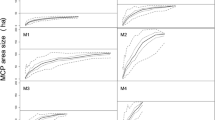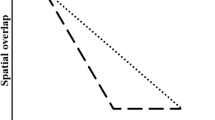Abstract
Sedentary Australian owlet-nightjars Aegotheles cristatus roost in cavities year-round, and are thought to mate for life and maintain stable home ranges throughout the year. These factors lead to the prediction that they should be highly territorial, yet nothing is known about their home range requirements or level of site fidelity. I used radio-telemetry coupled with GPS recordings to determine home range size in the semi-arid zone of central Australia (13 birds over two winters) and in a eucalypt woodland in the Northern Tablelands of NSW (14 birds over one calendar year). The mean home range in the eucalypt woodland was 17.7 ha based on the minimum convex polygon (MCP) method and 17.4 ha based on the fixed kernel contour (95%), whereas it was 23.8 ha and 24.1 ha based on the MCP and kernel methods in the desert respectively. With the exception of mated pairs (range overlap 41.9%), there was little overlap among individuals in home range areas (<13.0%), even in the densely populated woodland. Home range size did not differ significantly between seasons or study sites; nor was it correlated with arthropod abundance. Owlet-nightjars exhibited high site fidelity, using the same home range throughout the year with a 68% overlap between seasons. These data, plus anecdotal records of aggression and vocalizations, suggest that this species is highly territorial, yet individuals live in close proximity to conspecifics. The degree of territoriality may be due to the obligate cavity roosting behaviour of owlet-nightjars and the need to defend areas with known roost hollows.





Similar content being viewed by others
References
Anderson DE, Rongstad OJ (1989) Home-range estimates of red-tailed hawks based on random and systematic relocations. J Wild Manage 53:802–807
Atwood TC, Weeks HR Jr (2006) Spatial home-range overlap and temporal interaction in eastern coyotes: the influence of pair types and fragmentation. Can J Zool 81:1589–1597
Blakers M, Davies SJJF, Reilly PN (1984) The atlas of Australian birds. Melbourne University Press, Melbourne
Brigham RM, Geiser F (1997) Breeding biology of Australian owlet-nightjars Aegotheles cristatus in eucalypt woodland. Emu 97:316–321
Brown JL (1964) The evolution of diversity in avian territorial systems. Wilson Bull 76:160–169
Burt WH (1943) Territoriality and home range concepts as applied to mammals. J Mammal 24:346–352
Caccamise DF (1974) Competitive relationships of the common and lesser nighthawks. Condor 76:1–20
Cleere N, Nurney D (1998) Nightjars: a guide to nightjars and related nightbirds. Pica, East Sussex
Cody ML (1985) An introduction to habitat selection in birds. In: Cody M (ed) habitat selection in birds. Academic, Orlando, pp 3–56
Davey C, Pech R (2000) Abundance of nocturnal birds in central-western New South Wales. In: Holdsworth M (ed) Owls 2000, Canberra, Australia, 19–23 Jan 2000 (see http://www.ausraptor.org.au/owl2000.htm)
De Solla SR, Bonduriansky R, Brooks RJ (1999) Eliminating autocorrelation reduces biological relevance of home range estimates. J Anim Ecol 68:221–234
Debus SJS (1997) Vocal behaviour of the southern boobook Ninox novaeseelandiae and other nocturnal birds. Birds Aust Monograph 3:71–85
Doucette LI (2007a) Behavioural ecology and thermal physiology of the Australian owlet-nightjar (Aegotheles cristatus) (Ph.D. thesis). University of New England, Armidale
Doucette LI (2007b) Aggressive behaviour by Australian owlet-nightjars defending fledglings. Aust Field Ornith 24:60–63
Doucette LI, Geiser F (2008) Seasonal variation in thermal energetics of the Australian owlet-nightjar (Aegotheles cristatus). Comp Biochem Physiol A 151:615–620
Ford HA, Noske S, Bridges L (1986) Foraging of birds in eucalypt woodland in north-eastern New South Wales. Emu 86:168–179
Garrott RA, White GC, Bartmann RM, Weybright DL (1986) Reflected signal bias in biotelemetry triangulation systems. J Wildl Manage 50:747–752
Gilfillan SL (2001) An ecological study of a population of Pseudantechinus macdonnellensis (Marsupialia: Dasyuridae) in central Australia. II. Population dynamics and movements. Wildl Res 28:481–492
Gill FB (1995) Ornithology, 2nd edn. WH Freeman and Co., New York
Gorrell JV, Ritchison G, Morton ES (2005) Territory size and stability in a sedentary neotropical passerine: is resource partitioning a necessary condition. J Field Ornith 76:395–401
Hansteen TL, Andreassen HP, Ims RA (1997) Effects of spatiotemporal scale on autocorrelation and home range estimators. J Wildl Manage 61:280–290
Higgins PJ (1999) Family Aegothelidae owlet-nightjars. In: Higgins PJ (ed) Handbook of Australian, New Zealand & Antarctic birds: parrots to dollarbird, vol 4, 1st edn. Oxford University Press, Melbourne, pp 1036–1048
Hixon MA (1980) Food production and competitor density as the determinants of feeding territory size. Am Nat 115:510–530
Holyoak DT (2001) Nightjars and their allies: the Caprimulgiformes. Oxford University Press, Oxford
Hooge PN, Eichenlaub W, Solomon E (1999) The animal movement program. Version 2.0: USGS. Alaska Biological Science Center, Anchorage
Jackson HD (2000) Prey size in relation to mouth size of nightjars in Zimbabwe. Ostrich 71:436–437
Jackson HD (2002) Comparison of vocal behaviour in two Afrotropical nightjars: a whistler and a churrer. Ostrich 73:173–174
Jetz W, Steffen J, Linsenmair KE (2003) Effects of light and prey availability on nocturnal, lunar and seasonal activity of tropical nightjars. Oikos 103:627–639
Körtner G, Geiser F (1999) Roosting behaviour of the tawny frogmouth (Podargus strigoides). J Zool (Lond) 248:501–507
Lundberg A (1980) Vocalizations and courtship feeding of the Ural owl, Strix uralensis. Ornis Scandinavica 11:65–70
Mace GM, Harvey PH (1983) Energetic constraints on home-range size. Am Nat 121:120–132
Martin JK (2006) Den-use and home-range characteristics of bobucks, Trichosurus cunninghami, resident in a forest patch. Aust J Zool 54:225–234
Miller AH (1931) Systematic revision and natural history of the American shrikes (Lanius). Univ Calif Publ Zool 38:11–242
Odum EP (1941) Annual cycle of the black-capped chickadee. Auk 58:314–333
Orians G (1971) Ecological aspects of behavior. In: Farner D, King J, Parkes K (eds) Avian biology, vol I. Academic, New York, pp 513–546
Otis DL, White GC (1999) Autocorrelation of location estimates and the analysis of radiotracking data. J Wildl Manage 63:1039–1044
Pitelka FA (1959) Numbers, breeding schedule, and territory in pectoral sandpipers of Northern Alaska. Condor 61:233–264
Ritchison G, Cavanagh PM, Belthoff JR, Sparks EJ (1988) The singing behavior of eastern screech-owls: seasonal timing and response to playback of conspecific song. Condor 90:648–652
Rooney SM, Wolfe A, Hayden TJ (1998) Autocorrelated data in telemetry studies: time to independence and the problem of behavioural effects. Mamm Rev 28:89–98
Schodde R, Mason IJ (1980) Nocturnal birds of Australia. Lansdowne, Melbourne
Schodde R, Tideman SC (1990) Australian owlet-nightjar (Aegotheles cristatus). In: Schodde R, Tideman SC (eds) Reader’s digest complete book of Australian birds, 2nd edn. Readers Digest (Australia) Pty Ltd, Surry Hills, p 338
Schoener TW (1968) Sizes of feeding territories among birds. Ecology 49:123–141
Schoener TW (1981) An empirically based estimate of home range. Theor Popul Biol 20:281–325
Seaman DE, Millspaugh JJ, Kernohan BJ, Brundige GC, Raedeke KJ, Gitzen RA (1999) Effects of sample size on kernel home range estimates. J Wildl Manage 63:739–747
Smith GC, Hamley BJ, Park KM, Kehl JC (1993) Home range of plumed frogmouths Podargus ocellatus plumiferus during the non-breeding season as shown by radio-tracking. Emu 93:134–137
Spencer SR, Cameron GN, Swihart RK (1990) Operationally defining home range: temporal dependence exhibited by hispid cotton rats. Ecology 71:1817–1822
Swihart RK, Slade NA (1985) Testing for independence of observations in animal movements. Ecology 66:1176–1184
Swihart RK, Slade NA (1986) The importance of statistical power when testing for independence in animal movements. Ecology 67:255–258
Swihart RK, Slade NA (1997) On testing for independence of animal movements. J Agric Biol Environ Stat 2:48–63
von Haartman L (1957) Adaptation in hole-nesting birds. Evolution 11:339–347
Walsberg GE (1985) Physiological consequences of microhabitat selection. In: Cody M (ed) Habitat selection in birds. Academic, Orlando, pp 389–453
Walsberg GE (1986) Thermal consequences of roost-site selection: the relative importance of three modes of heat conservation. Auk 103:1–7
White GC, Garrott RA (1990) Analysis of wildlife radio-tracking data. Academic, San Diego
Worton BJ (1989) Kernel methods for estimating the utilization distribution in home-range studies. Ecology 70:164–168
Acknowledgments
Thanks to Fritz Geiser, Mark Brigham and Chris Pavey for their advice, Fred Harvey for extensive field assistance, and David Groth for performing DNA sexing. This study was facilitated by funding from the University of New England, the National Science and Engineering Council of Canada, and the Australian Research Council. Small grants were provided by Birds Australia, the Royal Zoological Society of New South Wales, and the Australian Bird Study Association. Permits for this research were issued by the University of New England Animal Ethics Committee, the Northern Territory Parks & Wildlife Commission, the New South Wales National Parks & Wildlife Service, and the Australia Bird & Bat Banding Scheme. This research complies with the current laws of Australia.
Author information
Authors and Affiliations
Corresponding author
Additional information
Communicated by T. Friedl.
Rights and permissions
About this article
Cite this article
Doucette, L.I. Home range and territoriality of Australian owlet-nightjars Aegotheles cristatus in diverse habitats. J Ornithol 151, 673–685 (2010). https://doi.org/10.1007/s10336-010-0497-9
Received:
Revised:
Accepted:
Published:
Issue Date:
DOI: https://doi.org/10.1007/s10336-010-0497-9




